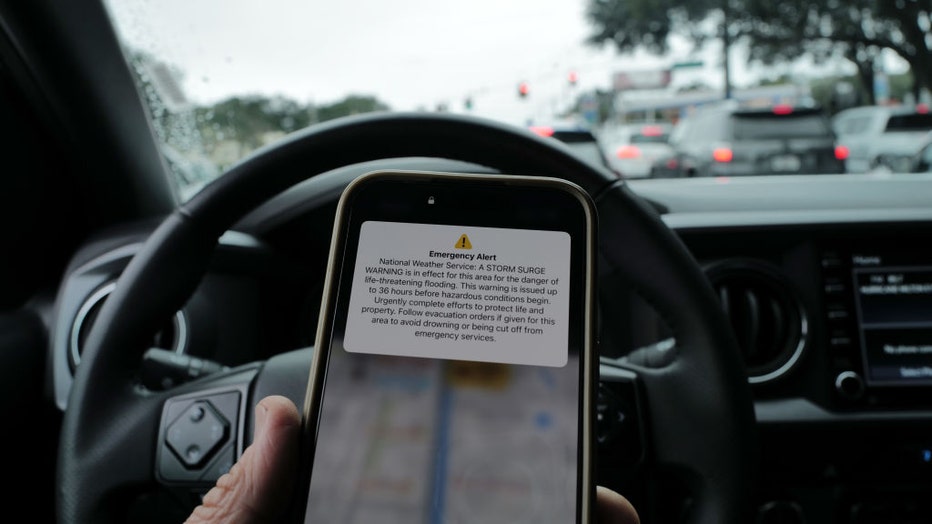Cell service outage Florida: How to set up satellite if cell service is down
With Hurricane Milton barreling through Florida on Thursday, communities are dealing with widespread damage to property, power outages and a loss of cell phone service.
Customers with each major carrier – including AT&T, Verizon, and T-Mobile – were all experiencing signal issues, slow or inaccessible data, and dropped calls thanks to Milton-damaged cell towers.
"Our network held up well for the most part but with this level of storm there are sites down in several areas including Tampa, Jacksonville, Miami and Orlando, among others," a T-Mobile update said Thursday. "This may be impacting service for customers in those areas.
AT&T and T-Mobile both announced they would be extending unlimited data to affected users who don't normally have that option on their plan.
How to use satellite mode
Although it is daunting when your phone is not working and you cannot contact loved ones, there are ways to access satellite service when this happens.
RELATED: Hurricane Milton aftermath: Millions without power as deaths, flooding reported
Satellites move fast and have limited bandwidth, and are located hundreds of miles away from Earth, meaning that sending or receiving a message via satellite is different from using cellular networks.

FILE-A weather alert is displayed on a phone as Hurricane Milton churns in the Gulf of Mexico on October 07, 2024 in Tampa, Florida. (Photo by Spencer Platt/Getty Images)
And your ability to use the satellite service or emergency services can also depend on your cell phone provider. Here’s what you need to know.
iPhone
Consumers with an iPhone 14 or newer can contact emergency services or send text messages via satellite if you are using Apple’s iOS 18 software.
Here are the steps provided by Apple for how to access the satellite connection.
- Open your Control Center by swiping down from the top right corner of your iPhone.
- Tap the Cellular button on the right of the Control Center.
- Tap Satellite, then tap Try Demo: To learn how to connect to a satellite, tap Try Connecting to Satellite. To learn how Emergency SOS via satellite works, tap Try Emergency SOS. You can also tap a satellite feature to learn more about it.
- To learn how to connect to a satellite, tap Try Connecting to Satellite.
- To learn how Emergency SOS via satellite works, tap Try Emergency SOS.
- You can also tap a satellite feature to learn more about it.
- Follow the onscreen instructions to practice connecting your iPhone to a satellite.
RELATED: Hurricane Milton threatens IV fluid supply, already thin after Helene
If you are having issues, you can also open directly to a demo of Emergency SOS via satellite or Messages via satellite by going to the following options in your phone's settings:
- Emergency SOS via satellite: Settings app > Emergency SOS
- Settings app > Apps > Messages, then scroll down and tap Satellite Connection Demo.
The satellite features are included at no cost for two years when you activate an iPhone 14 or later model, FOX Weather reported, citing Apple.
Satellites move quickly and have limited bandwidth, and are located hundreds of miles away from Earth, meaning that sending or receiving a message via satellite is different from using cellular networks.
Android
For Android users, the Google Pixel 9 series is the only device equipped with the capability to contact emergency services via satellite and is currently available in the U.S. only. The model phones with these capabilities are the Google Pixel 9, 9 Pro, 9 Pro XL, or 9 Pro Fold phone.
Google’s emergency satellite SOS features are also free for two years. The tech company says Google Messages must be set as your default messaging app.
These are the steps to follow to access emergency services.
- Call 911 — if this doesn’t work because you do not have cell service, users will see a Satellite SOS option on-screen. Tap it.
- Tap through the emergency questionnaire.
- Decide if you want to alert your emergency contacts as emergency services — if you do, tap the Notify button to send them your location and situation details.
- Users will be prompted to connect to a satellite, which involves going outside. Only do this if the situation is safe. The information you provided in the questionnaire will be sent to emergency services, and you will be able to communicate with emergency responders on the other end via text.
T-Mobile phones & Starlink
T-Mobile is working with Elon Musk’s Starlink to offer direct-to-cell service for areas impacted by Hurricane Milton.
According to SpaceX social media post, a phone connects to a Starlink satellite, it will have 1 to 2 bars of signal and show "T-Mobile SpaceX" in the network name. Users may have to manually retry text messages if they do not go through at first, as this is being delivered on a best-effort basis. The service works best outdoors, and occasionally works indoors near a window.
The company added that the team has enabled basic texting (SMS) for those on T-Mobile phones in hurricane affected areas. Text messages have already been sent and received. People can text loved ones, text 911 and continue to receive emergency alerts.
"We have accelerated the rollout of Starlink direct to cell phone connectivity for areas affected by the hurricanes," Elon Musk wrote on X, formerly Twitter, on Wednesday.
New users can also activate Starlink for free and the service will work for carriers outside of T-Mobile, according to Musk.

